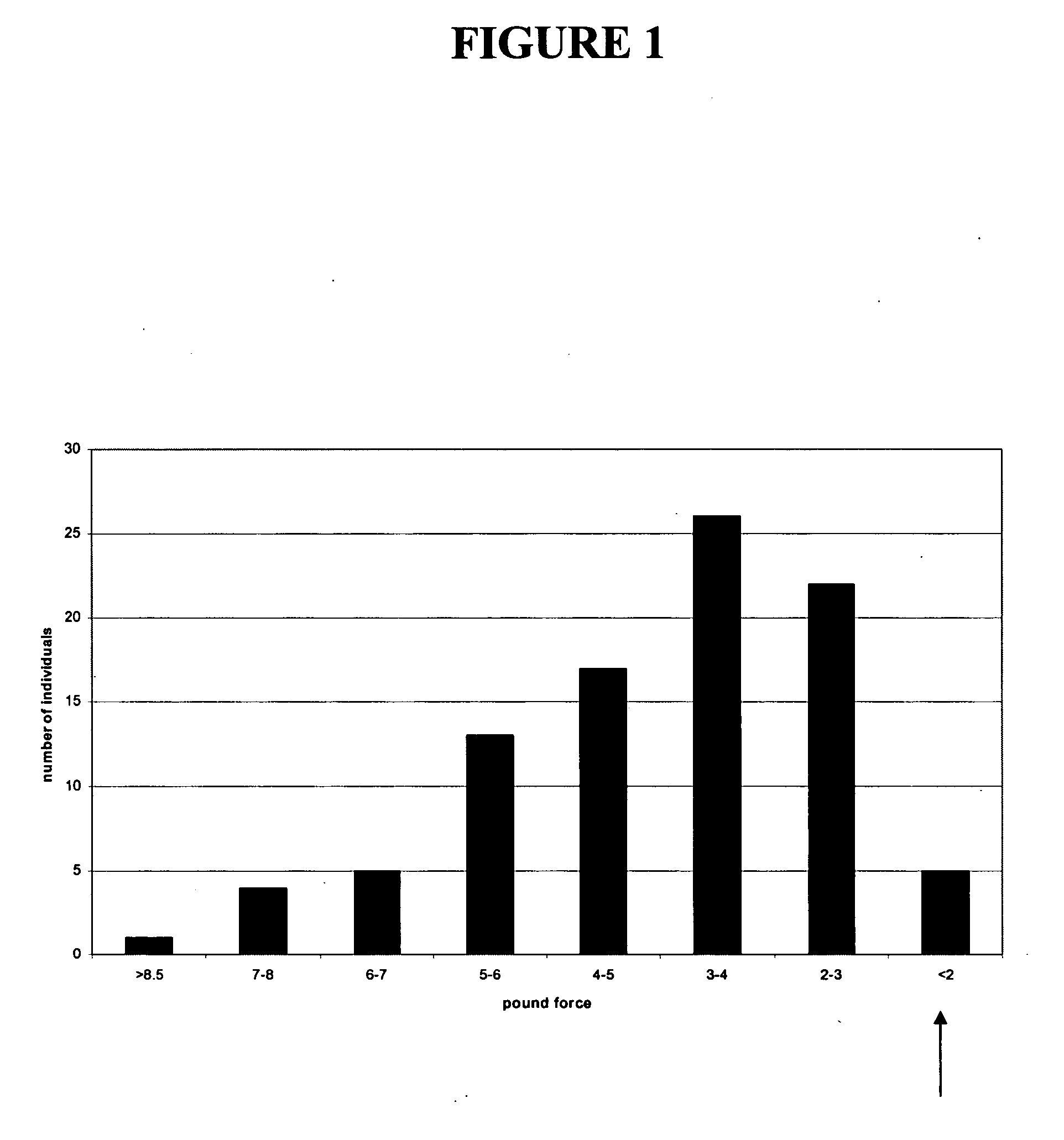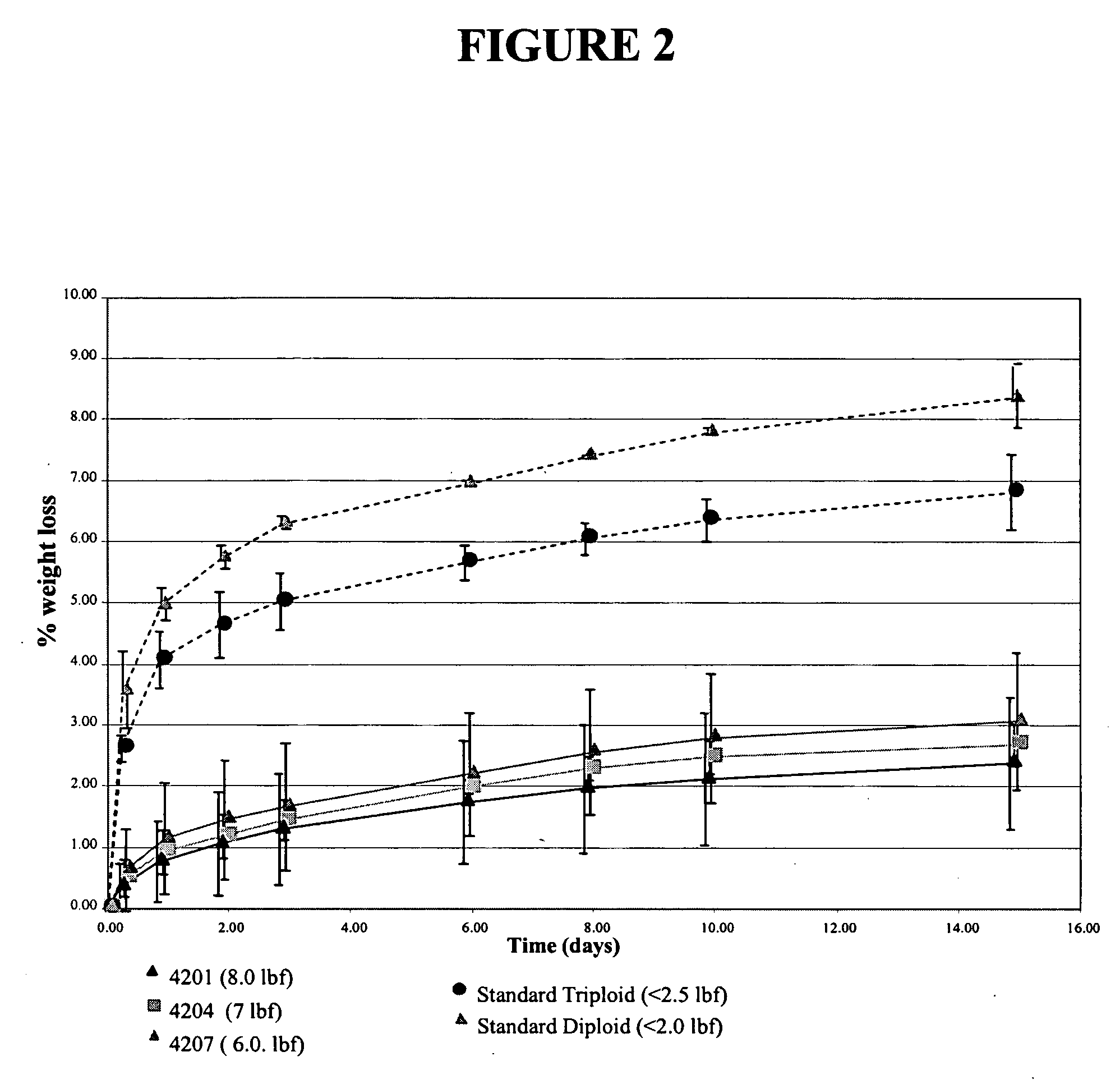Watermelon with improved processing qualities
- Summary
- Abstract
- Description
- Claims
- Application Information
AI Technical Summary
Benefits of technology
Problems solved by technology
Method used
Image
Examples
example 1
Generation of F1 Lines and Backcrosses
[0088] In the summer of 2000, four first filial (F1) generation lines were created by crossing 4 Seminis inbred lines as females to PI296341. The four diploid inbred lines used were W-2388, W-1128, W-1119 and W-1488. Line W-2388 is elongated in shape with a length to width (L / W) ratio of 1.8 to 2.2:1. The rind color and pattern is of medium green background with wide darker stripes. This shape and rind pattern phenotype is known to those skilled in the art as an “elongated dark mottle stripe” watermelon fruit. The fruit shape of Line W-1128 is round oval with L / W ratio of 1.0-1.2:1 and rind color is of light to medium green background and narrow darker green stripes. This phenotype is known to those skilled in the art as “round-oval with narrow (or tiger) stripes” watermelon fruit. Fruit shape of Line W-1119 is oval to high round with L / W ratio of 1.1-1.3:1. Rind color is medium green background with wide darker green stripes. This phenotype is...
example 2
Self-Pollinations of Plants Bearing Ultra Firm Flesh Fruit and Early Flesh Firmness Data
[0094] In the spring of 2002, the BC4 / BC4* generation was grown and evaluated qualitatively for sweet taste, fruit flesh firmness, and horticultural characteristics. Based on these evaluation criteria, plants were selected to create the next generation. Instead of creating another backcross generation, however, each selection from the lines being developed in parallel was self pollinated. The crossing produced the BC4S1 / BC4*S1 generation.
[0095] In the summer of 2002, the BC4S1 / BC4*S1 generation was grown and evaluated qualitatively for sweet taste, fruit flesh firmness, and horticultural characteristics. Based on these evaluation criteria, plants were selected to create the next generation. Self pollination of the selected plants created the BC4S2 / BC4*S2 generation.
[0096] In the fall of 2002, the BC4S2 / BC4S*2 generation was grown and evaluated qualitatively for sweet taste, fruit flesh firmnes...
example 3
Generation of Diploid Hybrids with Ultra Firm Flesh Trait
[0101] In the fall of 2002, in addition to the self pollinations, crosses with selected BC4S2 / BC4S*2 generation plants were made to other commercial inbreds that do not contain the ultra firm flesh phenotype. These crosses were made to test to what extent the ultra firm flesh trait would be dominantly inherited in a hybrid combination. Those skilled in the art will recognize the importance of establishing how well traits developed in inbred lines function in a hybrid combination.
[0102] In the spring of 2003, these test hybrids were evaluated in Florida and California. Although many hybrid combinations were tested in these trials, most of these data are not shown. Instead, data from four top performing hybrids across two trialing locations are shown in Tables 3 and 4. Hybrids were evaluated by a number of criteria, including the rind color pattern. For these hybrids, all had a mottled stripe pattern, designated MS. Also evalu...
PUM
 Login to View More
Login to View More Abstract
Description
Claims
Application Information
 Login to View More
Login to View More - R&D
- Intellectual Property
- Life Sciences
- Materials
- Tech Scout
- Unparalleled Data Quality
- Higher Quality Content
- 60% Fewer Hallucinations
Browse by: Latest US Patents, China's latest patents, Technical Efficacy Thesaurus, Application Domain, Technology Topic, Popular Technical Reports.
© 2025 PatSnap. All rights reserved.Legal|Privacy policy|Modern Slavery Act Transparency Statement|Sitemap|About US| Contact US: help@patsnap.com


